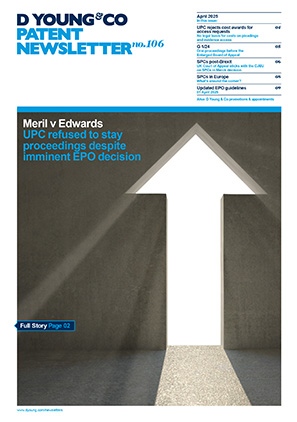25% UK corporation tax - innovate yourself down to 10% with a patent
On Friday 14 October 2022, the UK Government confirmed its intention to raise UK corporation tax from the current rate of 19%, to 25%, with effect from April 2023.Thus for those seeking to mitigate against this intended tax rise, now is an opportune time to be reviewing whether the UK Patent Box scheme might be applicable to their product line.
As background, the UK Patent Box scheme enables companies to apply a lower rate of corporation tax to profits earned from patented inventions. At its full benefit, the Patent Box scheme allows for a proportion of such profits to be levied at a substantially reduced rate of corporation tax rate of 10%, rather than the full rate which might otherwise be levied. Further information on the Patent Box scheme itself can be found in our article "Here comes the money…making sure to monetise your patenting and research efforts".
With this in mind, it is noted that utilisation of the UK Patent Box scheme requires there to be a granted patent which covers the commercially exploited product in question. So for those with patent applications which are currently in the pipeline (not yet granted), especially relating to the UK, now is really the time to be evaluating whether any of these patent applications might be pushed through to grant in time for the new rates of corporation tax which are due to take effect next year.
Acceleration of existing patent applications
In instances where a patent application, relating to the UK especially, already exists which does cover a commercially exploited product, it may be worth considering a request to accelerate the examination of the patent application, so it can be moved through to grant quicker than it otherwise might.
At least for patent applications relating to the UK, and which are submitted to the UK Intellectual Property Office (UKIPO) – which is the entity that handles national UK patent applications, the UKIPO does not charge for making a request for accelerated examination, though it does require a commercially valid reason as to why such an acceleration request should be allowed. Use of the Patent Box scheme has historically been deemed a valid reason in this respect.
Similarly, for those intending to achieve UK patent protection via a European patent application submitted before the European Patent Office (EPO), the EPO also does not charge for making an accelerated examination request, using the “PACE” acceleration procedure. There is also no reason needed for requesting PACE. Through the usage of this PACE scheme, the EPO will then aim to submit any next action at its end of the patent application within three months of the PACE request being made. So for any PACE request submitted in the next month or so, this might then mean that an allowance communication from the EPO might be able to be issued in time before thecorporation tax rise date of April 2023.
Amendments/divisionals
It might also be the case that there is a pending patent application, before the EPO or the UK, which although is not covering a commercially exploited product currently, could be tweaked or slightly amended to cover such a product, either by way of amending the claims of such a pending patent application, or by submitting a divisional patent application.
As background, a divisional patent application is one which is effectively split out from an existing patent application, with the new, divisional, application then being directed to a different invention which is otherwise described in the original patent application, but which has a different intended scope to that of the invention pursued in the patent application from which the divisional patent application derives.
If such a divisional patent application is pursued, again, acceleration can be used to help push it through to a successful conclusion sooner rather than later, to help have it designated under the UK Patent Box scheme as soon as possible.
If in doubt, a patent attorney should be able to help advise on whether an existing patent application, either by amendment, or by using a divisional patent application, might be mapped onto an existing commercially exploited product not yet covered under the UK Patent Box scheme.
New patent applications for new products
For those products which are not yet publically disclosed, and which are envisaged for commercial exploitation in the near future, thought should be given on whether there is anything from this product which might, in fact, be innovative enough to be covered with a patent, to help get the product under the Patent Box scheme.
When thinking about whether something is patentable, it often helps to think about whether any aspects of the product were particularly challenging, or required a lot of thought, to help devise. For instance, did an aspect of the product have to be shaped in a particular, unexpected, way, or was it necessary to use a particular material which was quite an unusual choice for a given technical reason? Or did doing something unexpected to the product result in some performance, or other technical enhancement, which was not initially foreseen?
In so far as there might be a product feature which can be identified as falling out from the above analysis, this can usually be a good initial indicator that something related to this may be patentable. Again, having these discussions with a patent attorney might be advisable, so they can assist with identifying any such feature(s) which might be potentially protected.
Documenting related R&D efforts
Whether something is ultimately patented or not, any work done by employees in devising technological improvements relating to a product should also be carefully documented and tracked, since these research-based activities may themselves be eligible for further forms of tax saving relief - notably in the form of R&D tax credits, and which can be used in addition to the UK Patent Box scheme. Further information on this additional form of research-based tax relief can be found in our earlier update: "Here comes the money…making sure to monetise your patenting and research efforts".
Conclusion
The UK Patent Box scheme is a truly fantastic scheme, which allows patents relating to the UK to not just act as a powerful enforcement tool, but also as a means for financially compensating those entities taking the time and effort to patent their hard-earned product innovations.
So do not delay; the UK Patent Box scheme is there to be capitalised on. Indeed, the cost savings to be had under the scheme in the medium-to-long term might far outweigh the cost of getting the patent in the first instance, even if the patent is never ultimately used for enforcement purposes.

